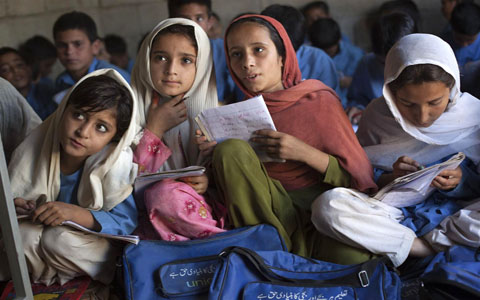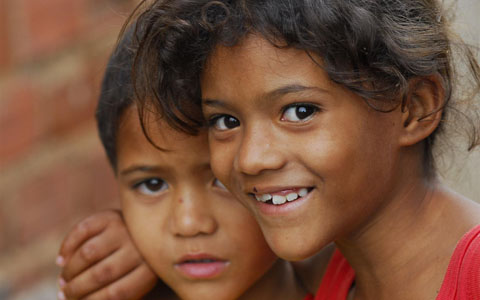On the anniversary of twentieth anniversary of the Convention on the Rights of the Child -- the most ratified human rights treaty in human history -- the leaders of five major organizations focusing on children make a joint plea to put children's best interests at the heart of human activity.
By Anne Lynam Goddard President and CEO, ChildFund International, Charlotte Petri Gornitzka, Secretary General, Save the Children Alliance, Kevin J. Jenkins, President and Chief Executive Officer, World Vision International, Richard Pichler, Secretary General, SOS Kinderdorf International, and Ann M. Veneman, Executive Director, UNICEF
 Twenty years ago this week, the U.N. General Assembly adopted a far-reaching and idealistic treaty that would dramatically alter the way the world looks at children. The Convention on the Rights of the Child, developed after years of intricate negotiations, offered a vision of a world in which all children survive and develop, and are protected, respected and encouraged to participate in the decisions that affect them.
Twenty years ago this week, the U.N. General Assembly adopted a far-reaching and idealistic treaty that would dramatically alter the way the world looks at children. The Convention on the Rights of the Child, developed after years of intricate negotiations, offered a vision of a world in which all children survive and develop, and are protected, respected and encouraged to participate in the decisions that affect them.
Based on four core principles -- non-discrimination; the best interest of the child; right to life, survival and development; and respect for the views of the child -- the Convention made it not just wise and just, but legally imperative for governments to recognize and uphold children's rights to such basic things as education, adequate healthcare, shelter and access to safe water and sanitation.
 Twenty years later, it is clear that the Convention has inspired a global movement for child rights and that laws have been changed to better protect children. Since 1989, the Convention has been ratified by 193 countries. More than 70 countries have incorporated children's codes into national legislation, as part of law reform efforts based on the Convention's provisions.
Twenty years later, it is clear that the Convention has inspired a global movement for child rights and that laws have been changed to better protect children. Since 1989, the Convention has been ratified by 193 countries. More than 70 countries have incorporated children's codes into national legislation, as part of law reform efforts based on the Convention's provisions.
The Convention also paved the way for the notion of protecting the "whole child," by articulating children's right to be safeguarded from violence, abuse and exploitation.
But 20 years later we also remember the unspeakable violations of rights that continue to occur. For millions of children, the rights guaranteed in the Convention have not become a reality.
One only has to look at the lives of the world's poorest and most marginalized children to see that the world does not fully respect the rights of its children.
 That an estimated 8.8 million children continue to die before they celebrate their fifth birthday is simply unacceptable. They die of diseases such as pneumonia, malaria and measles. They die because they are malnourished. They die because they do not have access to clean water and they die because they do not have access to basic medicines.
That an estimated 8.8 million children continue to die before they celebrate their fifth birthday is simply unacceptable. They die of diseases such as pneumonia, malaria and measles. They die because they are malnourished. They die because they do not have access to clean water and they die because they do not have access to basic medicines.
Other children lose their parents to the scourge of AIDS. Many children will never see the inside of a school room. Millions lack protection against violence, abuse, exploitation, discrimination and neglect.
Children are still trafficked and exploited. Girls are forced into marriages, and life-threatening childbirth, when they are still children themselves. Children in every corner of the earth need and deserve protection.
Fulfilling the promise of the Convention will require more than political commitment. It will require global solidarity for children's rights from every part of society - from governments and aid organizations to non-governmental organizations, the private sector, faith-based groups, parliamentarians, academic institutions, community groups, families, teachers, social workers, healthcare providers and children themselves.
The Convention has been -- and must continue to be -- a catalyst for broad collaboration that is essential to realizing the rights of children. Together, we must seize every opportunity to put the Convention's principles and provisions into practice. Through education, awareness-raising and advocacy, knowledge and acceptance of children's rights can become universal. We must lobby for resources to enforce laws protecting children and must hold our leaders accountable.
 The Convention on the Rights of the Child is a universal standard for building a better world -- a world in which the best interests of children are a primary concern for all. The challenge for the next 20 years is to build on the progress already achieved, collaborating to reach those children who are still being denied their rights to survival, development, protection and participation.
The Convention on the Rights of the Child is a universal standard for building a better world -- a world in which the best interests of children are a primary concern for all. The challenge for the next 20 years is to build on the progress already achieved, collaborating to reach those children who are still being denied their rights to survival, development, protection and participation.
We must work together to ensure that the primary test of governance is, first and foremost, the best interests of children. What better standard could there be?